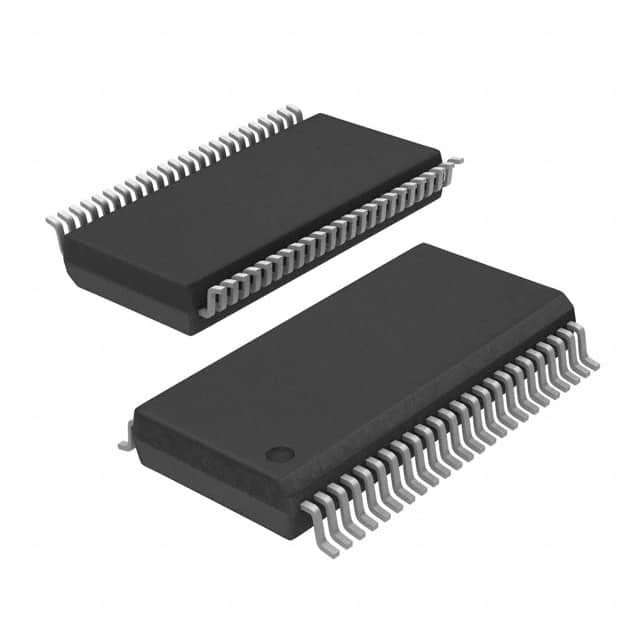Xem thông số kỹ thuật để biết chi tiết sản phẩm.

Encyclopedia Entry: 74ALVCH16245DTR
Product Overview
Category
The 74ALVCH16245DTR belongs to the category of integrated circuits (ICs), specifically a bus transceiver.
Use
This IC is commonly used for bidirectional data transfer between two buses with different voltage levels. It acts as a buffer, ensuring smooth communication between these buses.
Characteristics
- Bidirectional data transfer
- Supports voltage level translation
- High-speed operation
- Low power consumption
- Wide operating voltage range
Package and Quantity
The 74ALVCH16245DTR is available in a TSSOP package. It is typically sold in reels or tubes containing multiple units.
Essence
The essence of the 74ALVCH16245DTR lies in its ability to facilitate seamless data transfer between buses operating at different voltage levels, while maintaining high speed and low power consumption.
Specifications
- Supply Voltage Range: 1.2V to 3.6V
- Input Voltage Range: -0.5V to VCC + 0.5V
- Output Voltage Range: 0V to VCC
- Operating Temperature Range: -40°C to 85°C
- Maximum Data Rate: 400Mbps
Pin Configuration
The 74ALVCH16245DTR has a total of 48 pins, arranged in a dual in-line package (DIP). The pin configuration is as follows:
A1 ──────────────── B1
A2 ──────────────── B2
A3 ──────────────── B3
. .
. .
. .
A24 ──────────────── B24
OE GND ──────────────── VCC
DIR GND ──────────────── VCC
. .
. .
. .
ALE GND ──────────────── VCC
CLK GND ──────────────── VCC
Functional Features
- Bidirectional data transfer: The IC allows data to be transmitted in both directions, enabling communication between two buses.
- Voltage level translation: It supports the translation of voltage levels between the input and output sides, ensuring compatibility between different bus systems.
- High-speed operation: The 74ALVCH16245DTR is designed for high-speed data transfer, making it suitable for applications requiring rapid communication.
- Low power consumption: This IC is optimized for low power consumption, reducing energy requirements and enhancing overall efficiency.
Advantages and Disadvantages
Advantages
- Enables seamless data transfer between buses with different voltage levels.
- Supports high-speed operation, facilitating efficient communication.
- Low power consumption helps conserve energy.
- Wide operating voltage range enhances versatility.
Disadvantages
- May require additional components for proper implementation.
- Sensitive to electrostatic discharge (ESD), necessitating appropriate handling precautions.
Working Principles
The 74ALVCH16245DTR operates by receiving data from one bus and transmitting it to another. It incorporates level-shifting circuitry that ensures compatibility between the input and output voltage levels. The direction of data flow is controlled by the DIR pin, while the OE pin enables or disables the output buffers.
Application Field Plans
The 74ALVCH16245DTR finds application in various fields where bidirectional data transfer between buses with different voltage levels is required. Some potential application areas include:
- Industrial automation: Facilitating communication between control systems operating at different voltage levels.
- Automotive electronics: Enabling data exchange between various vehicle subsystems with varying voltage requirements.
- Consumer electronics: Supporting interconnection between devices operating at different voltage levels, such as smartphones and peripherals.
Alternative Models
For users seeking alternative options, the following ICs can be considered:
- SN74LVC245A: A similar bidirectional bus transceiver with comparable specifications.
- 74HC245: A non-inverting octal bus transceiver suitable for bidirectional communication.
- CD74HCT245: A high-speed CMOS logic bus transceiver offering voltage level translation capabilities.
These alternatives provide similar functionality to the 74ALVCH16245DTR and can be explored based on specific application requirements.
In conclusion, the 74ALVCH16245DTR is a versatile integrated circuit that enables efficient bidirectional data transfer between buses operating at different voltage levels. Its high-speed operation, low power consumption, and wide operating voltage range make it suitable for various applications in different industries.
Liệt kê 10 câu hỏi và câu trả lời thường gặp liên quan đến ứng dụng 74ALVCH16245DTR trong giải pháp kỹ thuật
Sure! Here are 10 common questions and answers related to the application of 74ALVCH16245DTR in technical solutions:
Q: What is the function of the 74ALVCH16245DTR? A: The 74ALVCH16245DTR is a 16-bit bus transceiver with 3-state outputs, used for bidirectional data transfer between two buses.
Q: What is the operating voltage range of the 74ALVCH16245DTR? A: The operating voltage range is typically from 1.65V to 3.6V.
Q: Can the 74ALVCH16245DTR handle level shifting between different voltage domains? A: Yes, it can be used for level shifting between different voltage domains as long as the voltage levels are within its specified range.
Q: How many channels does the 74ALVCH16245DTR have? A: It has 16 bidirectional channels, allowing for simultaneous data transfer on each channel.
Q: What is the maximum data rate supported by the 74ALVCH16245DTR? A: The maximum data rate is typically around 400 Mbps.
Q: Can the 74ALVCH16245DTR be used in high-speed applications? A: Yes, it is suitable for high-speed applications due to its low propagation delay and fast switching times.
Q: Does the 74ALVCH16245DTR support hot insertion and removal of devices? A: Yes, it supports hot insertion and removal without causing any damage to the device or the connected buses.
Q: Can the 74ALVCH16245DTR be used in both parallel and serial communication systems? A: Yes, it can be used in both parallel and serial communication systems, depending on the application requirements.
Q: What is the power supply current consumption of the 74ALVCH16245DTR? A: The power supply current consumption varies based on the operating conditions but is typically low.
Q: Are there any specific layout considerations for using the 74ALVCH16245DTR? A: It is recommended to follow proper PCB layout guidelines, including minimizing trace lengths, reducing noise coupling, and providing adequate decoupling capacitors near the device's power pins.
Please note that these answers are general and may vary depending on the specific datasheet and manufacturer's recommendations for the 74ALVCH16245DTR.

